
La Paz is the capital and largest city of the Mexican state of Baja California Sur, with a 2020 census population of 250,141 inhabitants, making it the most populous city in the state. La Paz City is located in La Paz Municipality—the fourth-largest municipality in Mexico, by area and populace, covering an area of 20,275 km2 (7,828 sq mi).

Zapopan is a city and municipality located in the Mexican state of Jalisco. Part of the Guadalajara Metropolitan Area, the population of Zapopan city proper makes it the largest city in the state, after the population of Guadalajara proper. It is best known as the home of the Virgin of Zapopan, an image of the Virgin Mary which was made in the 16th century. This image has been credited with a number of miracles and has been recognized by popes and even visited by Pope John Paul II. The municipality is also the home of the Centro Cultural Universitario, which contains one of the most important concert venues in Latin America and is the home of the new stadium for the C.D. Guadalajara.

Villa Guerrero is a municipality in the north of the state of Jalisco, México. It is located between 103°22′30″ and 103°50′00″ longitude west and 21°54′00″ and 22°10′00″ latitude north, at an altitude of 1,767 metres (5,797 ft) above sea level. The municipality covers an area of 673.3 square kilometres (260.0 sq mi).

Tonalá is a city and municipality within the Guadalajara Metropolitan Area in the state of Jalisco in Mexico. With a population of 442,440, it is the fourth largest city in the state, the other three being the other major population centres in the metro area: Guadalajara, Zapopan, and Tlaquepaque. It is best known as a major handcrafts center for Jalisco, especially pottery, as well as its very large Thursday and Sunday street market, dedicated to handcrafts.

The municipality and town of Totatiche is located in the northern extreme of the state of Jalisco, Mexico between 21°48’30” and 22°06’00” latitude north and 103°20’00” and 103°34’00” longitude east at a height of 1,751 meters (5,745 ft) above sea level. The municipality is bordered on the north and southeast by the state of Zacatecas. On the northeast, it shares its border with the municipality of Colotlán and on the west it is bordered by the municipalities of Villa Guerrero and Chimaltitán.

Bolaños Municipality is located in the north of the Mexican state of Jalisco.
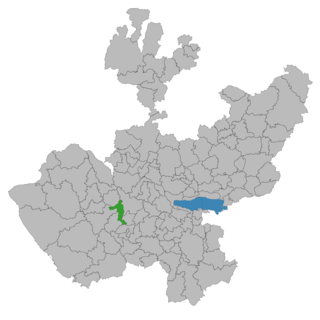
Tenamaxtlán is a municipio (municipality) and town in the Sierra de Amula Region in the state of Jalisco, Mexico.
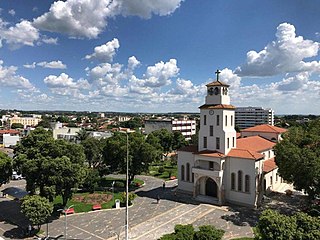
Lagoa da Prata is a Brazilian municipality in the state of Minas Gerais. In 2020, its population was estimated to be 52,711. The city belongs to the mesoregion of Central Mineira and to the microregion of Bom Despacho.
Otzoloapan Municipality is a municipality located at the southeast of the State of Mexico. The name is from the Náhuatl 'Oceloapan' which means "river of lynxes". It is located in the southwest part of the state bordering the state of Michoacán.

Mazamitla is a town and municipality of the Mexican state of Jalisco. It is located 124 km south of Guadalajara in the Southeast Region and is a popular resort destination for travelers from Guadalajara and nearby urban centers. Its name comes from the Nahuatl and means "place where arrows are made to hunt deer"; its area is 288.9 km2. According to Count II Population and Housing, the municipality has 11671 inhabitants who are devoted mainly to the tertiary sector. For its natural environment is considered by the federal Secretariat of Tourism as a Pueblo Mágico.
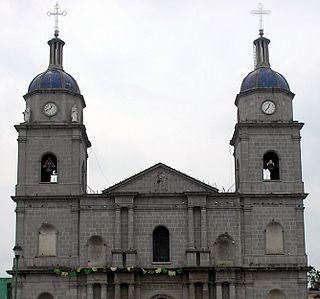
Tuxpan is a town and municipality in the Mexican state of Jalisco. The name "Tuxpan" comes from the Nahuatl word tochpan, a word used to describe where rabbits live or possibly place of abundant rabbits. Some others translate it as a location above the river.
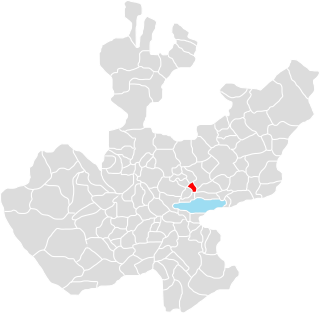
Juanacatlán is a town and municipio (municipality) in the central region of the Mexican state of Jalisco.
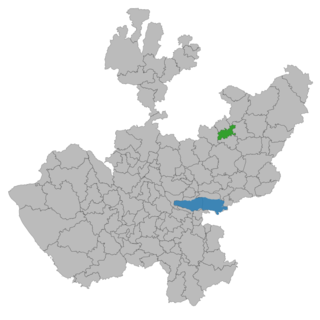
Cañadas de Obregón is a town and municipality, in Jalisco in central-western Mexico. It is located in the Altos Sur Region. The municipality covers an area of 182.09 square miles (271.8 km2).
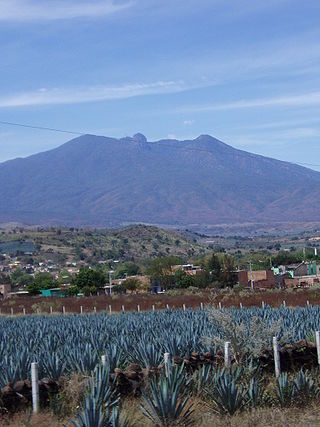
El Arenal is a town and municipality in the state of Jalisco in central-western Mexico. El Arenal is known as the gateway to the so-called "blue agave" region in the Jaliscan Highlands. The municipality has an area of approximately 111.8 square kilometres (43.2 sq mi).

La Manzanilla de La Paz is a town and municipality, in Jalisco in central-western Mexico. The municipality covers an area of 134 km². As of 2020, the municipality had a total population of 4,099.

Tapalpa is a town and municipality in Jalisco, a state of central-western Mexico. It has an oceanic climate.

Santa María del Oro is a town and municipality, in the Southeastern Region of Jalisco, in central-western Mexico. The municipality covers an area of 776.4 km2.
Zapotlán del Rey is a town and municipality in Jalisco in west-central Mexico. The municipality covers an area of 400 km2.

El Tuito is a Mexican agricultural town situated South of the Pacific Ocean's Bahía de Banderas in the Region Costa-Sierra Occidental of the Mexican state of Jalisco. It is the administrative and municipal seat of the municipality of Cabo Corrientes.

San Gerónimo Tlamaco is a locality in Mexico belonging to the municipality of Atitalaquia in the state of Hidalgo.






















